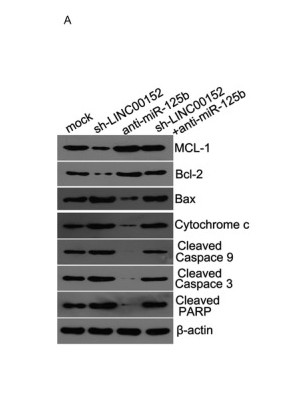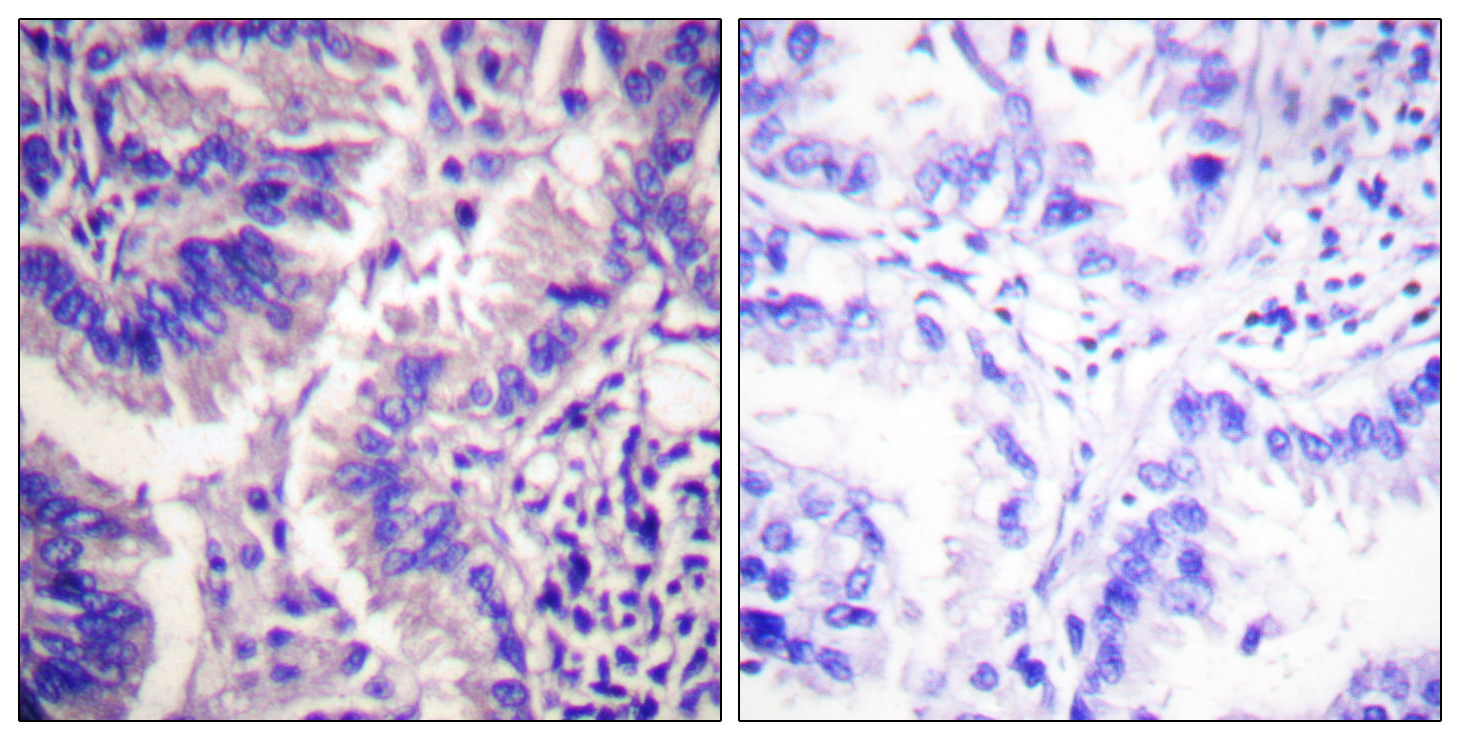Cleaved-Caspase-9 p35 (D315) Polyclonal Antibody
- Catalog No.:YC0014
- Applications:WB;IHC;IF;ELISA
- Reactivity:Human;Rat;Mouse;
- Target:
- Caspase-9
- Fields:
- >>Platinum drug resistance;>>p53 signaling pathway;>>PI3K-Akt signaling pathway;>>Apoptosis;>>Apoptosis - multiple species;>>VEGF signaling pathway;>>Thyroid hormone signaling pathway;>>Alzheimer disease;>>Parkinson disease;>>Amyotrophic lateral sclerosis;>>Huntington disease;>>Prion disease;>>Pathways of neurodegeneration - multiple diseases;>>Pathogenic Escherichia coli infection;>>Legionellosis;>>Toxoplasmosis;>>Tuberculosis;>>Hepatitis C;>>Hepatitis B;>>Measles;>>Human cytomegalovirus infection;>>Influenza A;>>Kaposi sarcoma-associated herpesvirus infection;>>Herpes simplex virus 1 infection;>>Epstein-Barr virus infection;>>Human immunodeficiency virus 1 infection;>>Pathways in cancer;>>Colorectal cancer;>>Pancreatic cancer;>>Endometrial cancer;>>Prostate cancer;>>Small cell lung cancer;>>Non-small cell lung cancer;>>Viral myocarditis;>>Lipid and atherosclerosis
- Gene Name:
- CASP9
- Protein Name:
- Caspase9
- Human Gene Id:
- 842
- Human Swiss Prot No:
- P55211
- Immunogen:
- The antiserum was produced against synthesized peptide derived from human Caspase 9. AA range:266-315
- Specificity:
- Cleaved-Caspase-9 p35 (D315) Polyclonal Antibody detects endogenous levels of fragment of activated Caspase-9 p35 protein resulting from cleavage adjacent to D315.
- Formulation:
- Liquid in PBS containing 50% glycerol, 0.5% BSA and 0.02% sodium azide.
- Source:
- Polyclonal, Rabbit,IgG
- Dilution:
- WB 1:500-2000, IHC 1:50-300, IF 1:50-300
- Purification:
- The antibody was affinity-purified from rabbit antiserum by affinity-chromatography using epitope-specific immunogen.
- Concentration:
- 1 mg/ml
- Storage Stability:
- -15°C to -25°C/1 year(Do not lower than -25°C)
- Other Name:
- CASP9;MCH6;Caspase-9;CASP-9;Apoptotic protease Mch-6;Apoptotic protease-activating factor 3;APAF-3;ICE-like apoptotic protease 6;ICE-LAP6
- Observed Band(KD):
- 35 46kD
- Background:
- CASP9 encodes a member of the cysteine-aspartic acid protease (caspase) family. Sequential activation of caspases plays a central role in the execution-phase of cell apoptosis. Caspases exist as inactive proenzymes which undergo proteolytic processing at conserved aspartic residues to produce two subunits, large and small, that dimerize to form the active enzyme. Caspase 9 can undergo autoproteolytic processing and activation by the apoptosome, a protein complex of cytochrome c and the apoptotic peptidase activating factor 1; this step is thought to be one of the earliest in the caspase activation cascade. Caspase 9 is thought to play a central role in apoptosis and to be a tumor suppressor. Alternative splicing results in multiple transcript variants.
- Function:
- catalytic activity:Strict requirement for an Asp residue at position P1 and with a marked preference for His at position P2. It has a preferred cleavage sequence of Leu-Gly-His-Asp-|-Xaa.,function:Involved in the activation cascade of caspases responsible for apoptosis execution. Binding of caspase-9 to Apaf-1 leads to activation of the protease which then cleaves and activates caspase-3. Proteolytically cleaves poly(ADP-ribose) polymerase (PARP).,function:Isoform 2 lacks activity is an dominant-negative inhibitor of caspase-9.,online information:Caspase-9 entry,PTM:Cleavages at Asp-315 by granzyme B and at Asp-330 by caspase-3 generate the two active subunits. Caspase-8 and -10 can also be involved in these processing events.,similarity:Belongs to the peptidase C14A family.,similarity:Contains 1 CARD domain.,subunit:Heterotetramer that consists of two anti-parallel arranged heterodimers
- Subcellular Location:
- nucleus,mitochondrion,cytosol,apoptosome,
- Expression:
- Ubiquitous, with highest expression in the heart, moderate expression in liver, skeletal muscle, and pancreas. Low levels in all other tissues. Within the heart, specifically expressed in myocytes.
Protective effect of luteolin on cigarette smoke extract‑induced cellular toxicity and apoptosis in normal human bronchial epithelial cells via the Nrf2 pathway. ONCOLOGY REPORTS Oncol Rep. 2014 Apr;31(4):1855-1862 WB Human NHBE cell
Long noncoding RNA LINC00152 promotes cell proliferation through competitively binding endogenous miR‐125b with MCL‐1 by regulating mitochondrial apoptosis pathways in ovarian cancer. Cancer Medicine Cancer Med-Us. 2018 Sep;7(9):4530-4541 WB Human,Mouse xenograft SKOV3 cell, A2780 cell
Comparison of two kinds of Agrocybe cylindracea polysaccharides: structural characteristic and antitumor activity. An-jun Liu WB Human MGC-803 cell
Enhancing metformin-induced tumor metabolism destruction by glucose oxidase for triple-combination therapy. Journal of Pharmaceutical Analysis Jianguo Xu IHC Mouse 4T1 cell-xenograft
The outer membrane protein Tp92 of Treponema pallidum delays human neutrophil apoptosis via the ERK, PI3K/Akt, and NF-κB pathways. MOLECULAR MICROBIOLOGY Yimou Wu WB Human human polymorphonuclear neutrophils (hPMNs)
Crosstalk between autophagy inhibitor and salidroside-induced apoptosis: A novel strategy for autophagy-based treatment of hepatocellular cancer. INTERNATIONAL IMMUNOPHARMACOLOGY Haixiang Su WB Human 1:1000 HepG2 cell,97H cell
Rosmarinic acid mitigates acrylamide induced neurotoxicity via suppressing endoplasmic reticulum stress and inflammation in mouse hippocampus PHYTOMEDICINE Tian-Bao Wang WB Mouse hippocampal
The gut microbiota contributes to the infection of bovine viral diarrhea virus in mice JOURNAL OF VIROLOGY Zecai Zhang WB Mouse peripheral blood lymphocytes (PBL)
- June 19-2018
- WESTERN IMMUNOBLOTTING PROTOCOL
- June 19-2018
- IMMUNOHISTOCHEMISTRY-PARAFFIN PROTOCOL
- June 19-2018
- IMMUNOFLUORESCENCE PROTOCOL
- September 08-2020
- FLOW-CYTOMEYRT-PROTOCOL
- May 20-2022
- Cell-Based ELISA│解您多样本WB检测之困扰
- July 13-2018
- CELL-BASED-ELISA-PROTOCOL-FOR-ACETYL-PROTEIN
- July 13-2018
- CELL-BASED-ELISA-PROTOCOL-FOR-PHOSPHO-PROTEIN
- July 13-2018
- Antibody-FAQs
- Products Images

- Chen, Puxiang, et al. "Long noncoding RNA LINC00152 promotes cell proliferation through competitively binding endogenous miR‐125b with MCL‐1 by regulating mitochondrial apoptosis pathways in ovarian cancer." Cancer medicine 7.9 (2018): 4530-4541.
poly-ihc-human-liver.jpg)
- Immunohistochemical analysis of paraffin-embedded Human-liver tissue. 1,Cleaved-Caspase-9 p35 (D315) Polyclonal Antibody was diluted at 1:200(4°C,overnight). 2, Sodium citrate pH 6.0 was used for antibody retrieval(>98°C,20min). 3,Secondary antibody was diluted at 1:200(room tempeRature, 30min). Negative control was used by secondary antibody only.
poly-ihc-human-lung.jpg)
- Immunohistochemical analysis of paraffin-embedded Human-lung tissue. 1,Cleaved-Caspase-9 p35 (D315) Polyclonal Antibody was diluted at 1:200(4°C,overnight). 2, Sodium citrate pH 6.0 was used for antibody retrieval(>98°C,20min). 3,Secondary antibody was diluted at 1:200(room tempeRature, 30min). Negative control was used by secondary antibody only.
poly-ihc-human-lung-cancer.jpg)
- Immunohistochemical analysis of paraffin-embedded Human-lung-cancer tissue. 1,Cleaved-Caspase-9 p35 (D315) Polyclonal Antibody was diluted at 1:200(4°C,overnight). 2, Sodium citrate pH 6.0 was used for antibody retrieval(>98°C,20min). 3,Secondary antibody was diluted at 1:200(room tempeRature, 30min). Negative control was used by secondary antibody only.

- Immunofluorescence analysis of Human-breast tissue. 1,Cleaved-Caspase-9 p35 (D315) Polyclonal Antibody(red) was diluted at 1:200(4°C,overnight). 2, Cy3 labled Secondary antibody was diluted at 1:300(room temperature, 50min).3, Picture B: DAPI(blue) 10min. Picture A:Target. Picture B: DAPI. Picture C: merge of A+B

- Western Blot analysis of various cells using Cleaved-Caspase-9 p35 (D315) Polyclonal Antibody diluted at 1:1000
.jpg)
- Western Blot analysis of 293 cells using Cleaved-Caspase-9 p35 (D315) Polyclonal Antibody diluted at 1:1000

- Immunohistochemistry analysis of paraffin-embedded human lung carcinoma tissue, using Caspase 9 (Cleaved-Asp315) Antibody. The picture on the right is blocked with the synthesized peptide.



